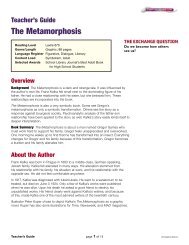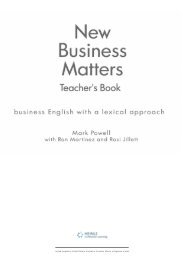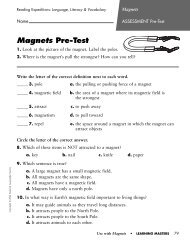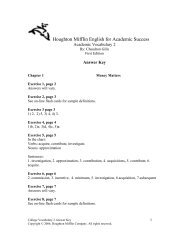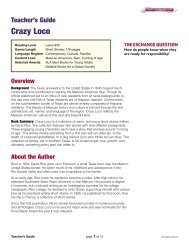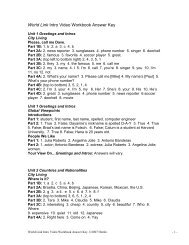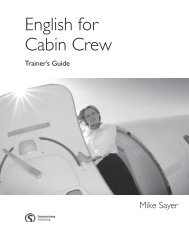<strong>Top</strong> <strong>20</strong>, <strong>Great</strong> <strong>Grammar</strong> <strong>for</strong> <strong>Great</strong> <strong>Writing</strong>, <strong>First</strong> <strong>Edition</strong><strong>Teaching</strong> <strong>Notes</strong>http://esl.college.hmco.com/instructorsCopyright Houghton Mifflin CompanyChapter 9 – Modals: Present and FutureOverviewThis chapter focuses on single-word and phrasal modals used in the present and past. Thechapter is organized by modal meaning rather than by individual modal, e.g, all the modals usedto express permission and request (can, may, could, might, will, would) are presented as a group.The chapter is divided into seven groups: permission and requests; possibility and probability;ability; preference and desire; necessity, prohibition, and lack of necessity; advisability andsuggestion; and prediction, intention, and expectation.These seven meaning groups and some examples of modals + verb open the chapter. Studentsare then presented with two lists: single-word modals and phrasal modals and with some basicrules <strong>for</strong> using modals.To introduce students to this chapter, begin by asking students to share what they know aboutmodal verbs in English. Create a chart on the board with columns headed meaning, modal, andrule. List in<strong>for</strong>mation from the student in the appropriate column. When students have finishedoffering what they know, draw their attention to the meanings listed in the chapter opener. Fillin the meaning column with whatever in<strong>for</strong>mation might be missing. Do the same with the tworemaining columns, checking the book to compare what in<strong>for</strong>mation still needs to be added tothe column on the board. Ask students to <strong>for</strong>m example sentences using some of the modals.<strong>Teaching</strong> <strong>Notes</strong>Modals <strong>for</strong> Permission and Request (9.3)Introduce these modals by asking students to imagine they are sitting in an office, ready to fillout an application (<strong>for</strong> study or work) when their pencil breaks. They need to ask the person atthe desk or the person sitting next to them <strong>for</strong> a pencil. Elicit ways they might ask <strong>for</strong> a pencil,pointing out the difference in the way they might ask an office receptionist as opposed to a peer.Go over the examples in the text, emphasizing the <strong>for</strong>mal vs. in<strong>for</strong>mal requests, requests vs.permission. Spend some time practicing examples with Would you mind to make sure studentsunderstand the meaning to the responses.Follow with Exercise 1. If students need more practice, assign pairs to write dialogues. Assignscenarios ranging from very <strong>for</strong>mal to very in<strong>for</strong>mal (mayor and citizen, supervisor andemployee, two cousins, etc.)1
Modals of Possibility and Probability (9.4)Write situations similar to the following on the board and ask students to assign a percent basedon how certain they are that the situation exists/will exist: It will rain/snow tomorrow, Allstudents will understand this chapter, The President will be re-elected, The answers were writtenby the author, PCs cost less than laptops, etc.Use the different percents to introduce the modals (should, has/to, must, can, may, might could).Review the examples presented in the text with the students. Follow up with Exercise 2. Ifstudents need additional practice, have them find examples of sentences using the modals innews articles, magazines, short stories, etc. and share them with their classmates.Modals of Ability (9.5)Introduce can and be able to by writing phrases on the board or on cards, e.g., ride a bike, fly aplane, speak a third language, etc. Have students ask each other questions and answer using themodals. Follow up with Exercise 3.Modals of Preference and Desire (9.6)Introduce these modals by offering students alternative activities (e.g., read fiction or watch amovie; eat out or cook at home, etc.) and asking them which they would rather do, which theywould prefer to do, etc. Point out the different <strong>for</strong>ms <strong>for</strong> would rather, would prefer (to), andwould like listed in the text. Draw attention to the special note regarding the use of would inconditionals or sentences with wish.Have the students brainstorm two lists: one of enjoyable activities and one of less enjoyableactivities. In pairs, have students practice asking each other questions about their preferences.Have students do Exercise 4 individually and compare answers with a partner. Go over theexercise with the entire group. Follow up with an out-of-class assignment asking students towrite an advertisement or make a commercial selling a product, using the modals of preferenceand desire in their ads.Modals of Necessity, Prohibition, and Lack of Necessity (9.7)Some students have an especially difficulty time understanding the difference between must notand don’t have to. Introduce these modals, emphasizing the necessity or lack thereof <strong>for</strong> eachexample. Ask students to contribute examples of their own. Follow with Exercise 5. An out-ofclassactivity <strong>for</strong> those who need more practice might require students to locate writtenexamples, found perhaps on warning labels, caution signs, etc.Modals of Advisability and Suggestion (9.8)Introduce the concept of giving advice and making suggestions by listing some problems thatyou or your friends or <strong>for</strong>mer students have had (e.g., car tires are losing air, a married couplewants to go to two different places on vacation, getting homework done on time). Ask students<strong>for</strong> possible solutions. On the board, list the different modals to be practiced, one column <strong>for</strong>advice and one <strong>for</strong> suggestions. Have students alternate giving solutions using should and couldto show the difference between advice and suggestions.2
- Page 1 and 2: Top 20, Great Grammar for Great Wri
- Page 3 and 4: Explain the form. This tense always
- Page 5 and 6: Top 20, Great Grammar for Great Wri
- Page 7 and 8: Top 20, Great Grammar for Great Wri
- Page 9 and 10: Top 20, Great Grammar for Great Wri
- Page 11 and 12: Top 20, Great Grammar for Great Wri
- Page 13 and 14: Top 20, Great Grammar for Great Wri
- Page 15 and 16: class. Have students complete Exerc
- Page 17 and 18: Exercise 6 uses something that most
- Page 19: the proper word if they misused a w
- Page 23 and 24: Top 20, Great Grammar for Great Wri
- Page 25 and 26: Top 20, Great Grammar for Great Wri
- Page 27 and 28: Top 20, Great Grammar for Great Wri
- Page 29 and 30: Top 20, Great Grammar for Great Wri
- Page 31 and 32: Top 20, Great Grammar for Great Wri
- Page 33 and 34: This section addresses the most com
- Page 35 and 36: Before beginning Exercise 5, have s
- Page 37 and 38: A very common test item on TOEFL, p
- Page 39 and 40: Exercise 5 is a simple mechanical t
- Page 41 and 42: Because versus because of (18.4)The
- Page 43 and 44: Exercise 5 is difficult because of
- Page 45: Introduce the pairs of words by goi



